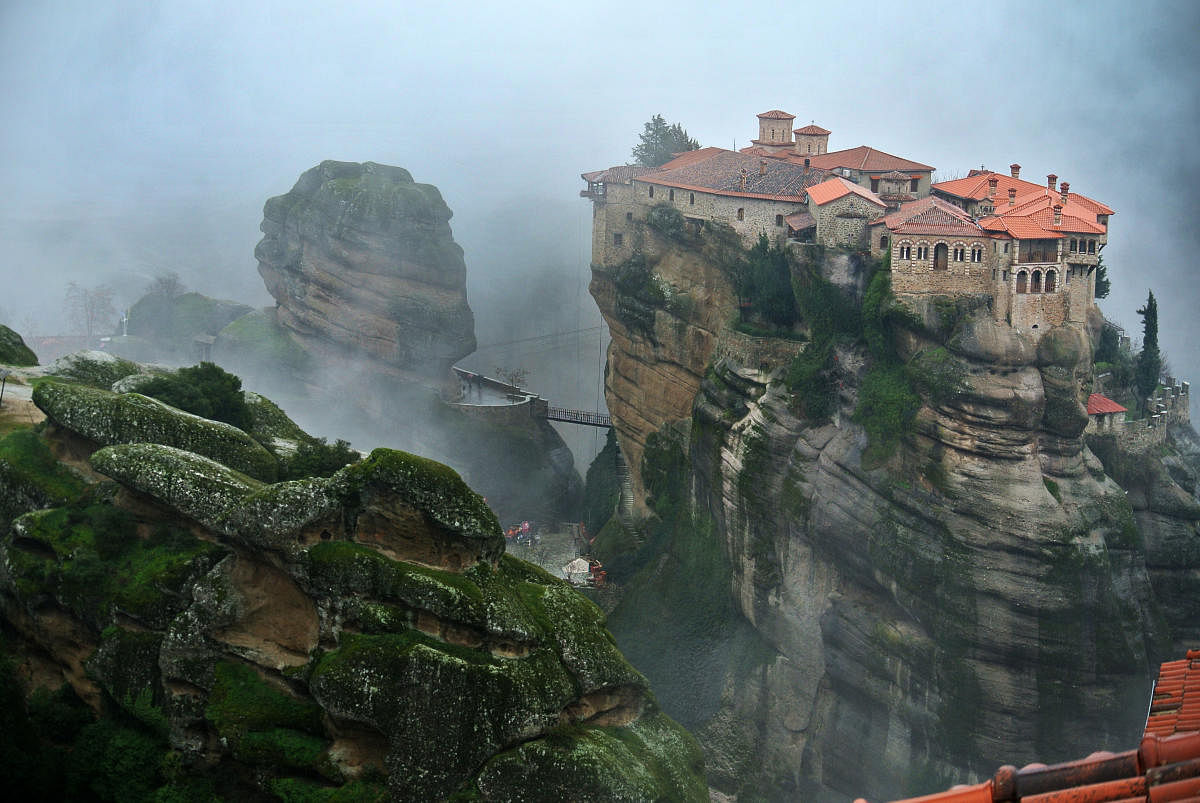
Kalambaka - the name sounds like a character out of the Mahabharata, or maybe even the Rig Veda. Certainly not the first name that pops up in your mind when you think of Greece. However, the town of Kalambaka is indeed in Greece, nestled in the plains of Thessaly, about four hours ride north of Athens.
Our image of Greece, like most other people, begins with the myths of the Gods of Olympus and centres around Athens the city state and its architectural wonders -Parthenon, Elgin Marbles and all that goes with it.
As we research on ways to get to Delphi - home of the famous Oracle - that's when we first read about Meteora. The monasteries of Meteora were built as a refuge for monks fleeing the Turkish invasion of Greece in the 14th century. More than 20 monasteries were originally built, out of which only six remain today.
Driving past Kalambaka towards Meteora, the scene in front of us is like a page straight out of a The Phantom comic. We seem to have stumbled upon Walker's Table - a sheer tube of rock that rises from the surrounding plains. But here we see numerous rock pillars, six of which are topped with monasteries.
Nothing quite prepares us for the utterly awe-inspiring monasteries of Meteora.
'Meteora' in Greek means 'suspended in the air'. The dramatic landscape of Kalambaka and the monasteries perched on the natural sandstone pillars are ethereal. It's easy to imagine how these highly visible monasteries through their very inaccessibility gave the monks and nuns the needed privacy and security for their spiritual pursuits.
Lofty conditions
At the crack of dawn, we head out from our hotel in Kalambaka towards the monasteries, and drive along the winding roads that wrap around the mountains. Soon the road is lined with cars hugging the mountains on one side, even as more tourist buses and cars wind their way upwards. A large flat parking area appears and we are at the entrance of the monastery of the Great Meteoron, the largest in the complex. The monastery was founded by St Athanasios of Athos, and gained importance because of his disciples, that included Ioasaph, the King of Serbia who renounced his worldly pleasures to become a monk, and John Cantacuzene, the Byzantine emperor.
Even from the parking lot, where hundreds of steps reach upwards, to the monastery's entrance, the view into the valley is breathtaking. The wind, which we barely notice in the plains, blows hard and threatens to knock us over. It's hard for us to imagine how the monks climbed this high on just a rope and a pulley system of baskets. The very thought is dizzying.
As we walk up nearly 400 steps to the entrance of the monastery, we have to stop a couple of times to catch our breath. The light jackets that we're wearing seem to be a poor choice for the raging wind. Soon, as we step into the monastery foyer, a monk helpfully points to a sign on the wall. A dress code posted there bans all visitors from wearing sleeveless outfits or shorts.
Women are required to wear long skirts; men have to wear pants.
Fortunately, the monastery offers, for free, wrap-around skirts for women right next to the sign. The first chapel within the monastery was completed in 1388, and forms the sanctuary of the church, which we tour. Within it is the tomb of Athanasios and Ioasaph (the King of Serbia). The church is adorned with frescoes dedicated to the Transfiguration of Christ. Scenes from the life of Christ, images of Virgin Mary and the founder saints, Athanasios and Ioasaph, form the majority of images. Some frescoes show gruesome scenes depicting the persecution of early Christian saints by the Romans. Gilded icons and religious paintings that line the walls show exquisite workmanship with unusual animal and plant motifs. The refractory on one side of the church has a museum that contains religious manuscripts and crosses made of wood.
A quick detour to the kitchen reveals an old-fashioned oven, and beyond this is the wine cellar filled with barrels and wine jugs. The macabre sight of skulls of monks in the sacristy near the cellar has us stumped momentarily - a slight shiver accompanies the sense of awe we feel. We head out blinking into the sunlight of a stone-paved courtyard, at one end of which the remnants of the old basket and pulley system can be seen. The valley seems very far down; it's easy to imagine being closer to heaven up at this height.
One for the nuns
Our next stop is the Roussanou, a monastery inhabited by nuns. It's much smaller in comparison to the Great Meteoron. At the monastery we see a bare room, much like the ones the nuns inhabit even today. The nuns are friendlier and sell us white stones handpainted with a silhouette of monastery-topped mountain. Our tour is over sooner than we anticipate, and we find ourselves in a flat, circular observation area that runs practically around the steps leading down the mountain.
We sit on the benches looking into the valleys nearby and mountains all around. Next to us is a couple who have biked all the way from Germany to experience the wonders of Meteora. Silence envelopes us and the setting sun makes for a special display of colours on the mountaintops. We experience a feeling of bliss as the magic of Meteora slowly seeps into us.